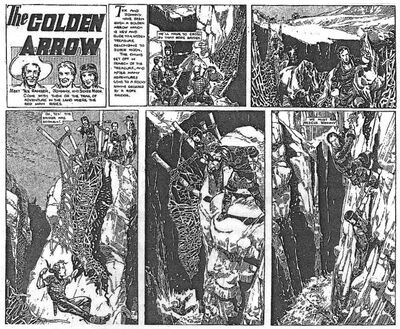
"The Golden Arrow", Puck, 1937
Reginald Perrott was born in Charlton, Woolwich, South-East London, on 18 October 1914, the son of Edward Perrott, a metal turning machinist, and his wife Susan, née Tingley. He had no formal art training, but by the age of nineteen he was working for Adams and Fidler, an agency that created puzzles and features for the press, which also employed Basil Reynolds.
The agency had won a contract to create comic strips for newspapers owned by the Provincial and National Press, and Perrott started working on "funnies" strips, believing his figure-drawing was not up to drawing adventure strips. Early strips he drew included At the Jungle School for Reynolds Illustrated Sunday News, and Roly and Poly, the Two Bear Cubs for the London Evening Star. He also worked on newspapers' children's supplements like the Daily Express Children's Own, the South Wales Echo and the Bristol-based Boys' and Girls' Own Evening World, where he drew his first adventure strip, The Luck of the Legion (1934). He became the agency's go-to adventure artist, drawing Tanga the Tiger Man and Code of the Northland for the Evening World, Buster and Bones for the Boys' and Girls' Own Yorkshire Evening News, and Land of the Lost People (publication unknown), before going freelance in late 1934.
He started working for the weekly comics of the Amalgamated Press, drawing "Whirling Around the World" (1934) for The Joker and "Wheels of Fortune" (1935) for The Jolly Comic. The following year he was recruited to draw for Odhams Press' Mickey Mouse Weekly by its studio manager, his old colleague Basil Reynolds. His first strip for the title was "The Road to Rome" (1936), inspired by the film Ben-Hur and influenced by the work of illustrator Fortunino Matania. Perrott introduced cinematic storytelling techniques, varying angles and panel shapes, and eliminated the traditional typeset narration under the panels, preferring to hand-letter captions between panels. He followed this with two colour strips, the western "White Cloud" (1936) and the Elizabethan naval adventure "Song of the Sword" (1936). Other strips he drew for the title included "A Crusader's Christmas" (1937), "Wings of Fortune" (1938) and "Rescuer's Reward" (1938).
He continued working for the Amalgamated Press, drawing "The Young Explorers" (1936) for Puck in traditional panels-with-typeset-narration style, but his next strip for the title, a western called "The Golden Arrow" (1937), was told with varied panel shapes, cinematic angles and hand-lettered speech balloons, and only occasional captions, hand-lettered between the panels.
Perrott was ahead of his time as an adventure artist, and his stylistic innovations did not become common until the late 1940s. Indeed, Perrott himself was restricted to the traditional approach on other strips, like "The Golden Eagle" (1937-40) for Golden, "The Red Rider" (1938-39) for The Jolly Comic, and "Sons of the Sword" (1938) for Happy Days'.
He served in the RAF during the Second World War, but was invalided out with malaria in 1944, having seen no action. He became studio manager of Mickey Mouse Weekly, in place of Basil Reynolds, who was fighting in North Africa. drawing covers as well as strips like "Sir Roger de Coverlet" (1944) and "The White King of Arabia" (1945).
When Reynolds returned after the war, Perrott went freelance again, illustrating adventure novels. His last work in comics was a science fiction strip called "Spaceship to the Moon" in Look and Laugh, published by Philmar in 1947. He was also known for his war art: three of his paintings are held by the Imperial War Museum in London.
Perrott died of throat cancer in Tonbridge, Kent, on 16 May 1947, aged only 32, leaving a wife, Joan, née Budd, whom he had married in 1940, and a young daughter, Rosemary, born in 1943.
References[]
- Alan Clark, Dictionary of British Comic Artists, Writers and Editors, The British Library, 1998, pp. 133-134
- Dennis Gifford, Encyclopedia of Comic Characters, Longman, 1987, p. 7
- Norman Wright and David Ashford, Masters of Fun and Thrills: The British Comic Artists Vol 1, Norman Wright (pub.), 2008, pp. 145-156